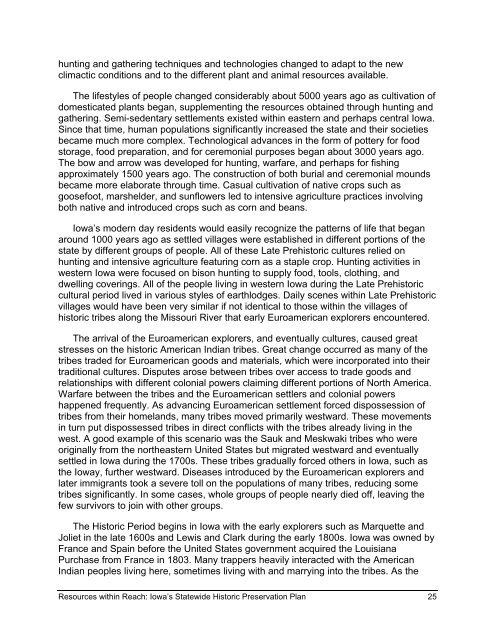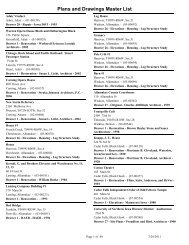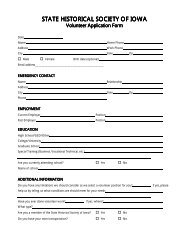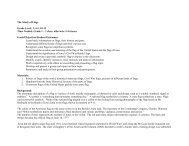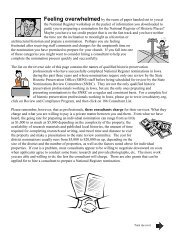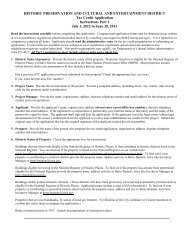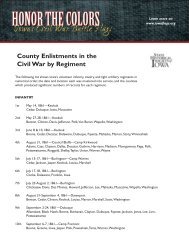settlements. Many <strong>of</strong> <strong>Iowa</strong>’s current and former historic towns are located at leastpartially on these glacial outwash terraces. The thick sand and gravel deposits <strong>within</strong>these terraces became a very important commodity historically for use primarily asconstruction materials. Sand and gravel mining remains a major industry yet today in<strong>Iowa</strong>. Some <strong>of</strong> <strong>Iowa</strong>’s most significant paleontological and archeological discoverieshave been discovered, and sometimes completely destroyed, as a result <strong>of</strong> sand andgravel mining.The modern courses <strong>of</strong> most rivers and streams were created as a result <strong>of</strong> theglacial activities. The rivers and streams would become important transportation andtrade routes for people in the past and particularly during the early historical period. Therivers were full <strong>of</strong> fish <strong>of</strong> all shapes and sizes, enormous mussel beds, and valuableaquatic plants that people in the past heavily utilized. The early historic industries <strong>of</strong>commercial and subsistence fishing and the former mussel shell button manufacturingbusinesses remind us <strong>of</strong> what the rivers formerly provided. Many <strong>of</strong> the rivers werehistorically harnessed and constrained in the middle and late 1800s by the installation <strong>of</strong>dams for use in early milling operations and for the creation <strong>of</strong> electricity. Currently, thedams are being maintained and some new dams have been constructed primarily forwater management purposes related to flood control, water quality, recreationalpurposes, and transportation <strong>of</strong> materials in the Missouri and Mississippi Rivers.The last glacier in the state <strong>of</strong> <strong>Iowa</strong> ended approximately 12,000 to 14,000 yearsago. It left a visible reminder <strong>of</strong> its presence by creating a distinct landscape in northcentral <strong>Iowa</strong> known as the Des Moines Lobe. It received this name since thesouthernmost extent <strong>of</strong> the glacier reached the city <strong>of</strong> Des Moines. This landscapefeatured glacial landforms including natural lakes and prairie potholes <strong>of</strong> all shapes andsizes. Much <strong>of</strong> the land supported magnificent tallgrass prairies filled with bison, elk,and many other animal species that arriving peoples hunted, while lakes and streams<strong>of</strong>fered waterfowl, fish, cattails, bulrushes, and even wild rice. Many <strong>of</strong> these extensivewetlands were eventually drained to bring their valuable soils under modern agriculturaluse. Peat was occasionally historically mined in some areas for use as fuel. Several <strong>of</strong>the larger lakes remained and became popular resort and recreation areas in the late1800s and early 1900s.It is not clear when the first people arrived in <strong>Iowa</strong> or from where they came. Basedon oral traditions and beliefs <strong>of</strong> several <strong>of</strong> the American Indian tribes, they have beenhere since the Earth was created. From an archeological perspective, it appears thatpeople first arrived in <strong>Iowa</strong> approximately 13,000 years ago at the end <strong>of</strong> the last glacialperiod. Archeological study and the study <strong>of</strong> past human cultures provides the basis forinterpreting and understanding the groups <strong>of</strong> people that lived in <strong>Iowa</strong> before recordedhistory.For over 8000 years after the arrival <strong>of</strong> the first groups <strong>of</strong> people, a hunting andgathering lifestyle was practiced that changed with the seasonal availability <strong>of</strong> plantsand animals. During this time period, a major shift in climate occurred as the glacialconditions ceased and many large mammals that inhabited <strong>Iowa</strong> during the glacialactivities became extinct, including bison, mammoths, and ground sloths. As a result,<strong>Resources</strong> <strong>within</strong> <strong>Reach</strong>: <strong>Iowa</strong>’s <strong>State</strong>wide Historic Preservation Plan 24
hunting and gathering techniques and technologies changed to adapt to the newclimactic conditions and to the different plant and animal resources available.The lifestyles <strong>of</strong> people changed considerably about 5000 years ago as cultivation <strong>of</strong>domesticated plants began, supplementing the resources obtained through hunting andgathering. Semi-sedentary settlements existed <strong>within</strong> eastern and perhaps central <strong>Iowa</strong>.Since that time, human populations significantly increased the state and their societiesbecame much more complex. Technological advances in the form <strong>of</strong> pottery for foodstorage, food preparation, and for ceremonial purposes began about 3000 years ago.The bow and arrow was developed for hunting, warfare, and perhaps for fishingapproximately 1500 years ago. The construction <strong>of</strong> both burial and ceremonial moundsbecame more elaborate through time. Casual cultivation <strong>of</strong> native crops such asgoosefoot, marshelder, and sunflowers led to intensive agriculture practices involvingboth native and introduced crops such as corn and beans.<strong>Iowa</strong>’s modern day residents would easily recognize the patterns <strong>of</strong> life that beganaround 1000 years ago as settled villages were established in different portions <strong>of</strong> thestate by different groups <strong>of</strong> people. All <strong>of</strong> these Late Prehistoric cultures relied onhunting and intensive agriculture featuring corn as a staple crop. Hunting activities inwestern <strong>Iowa</strong> were focused on bison hunting to supply food, tools, clothing, anddwelling coverings. All <strong>of</strong> the people living in western <strong>Iowa</strong> during the Late Prehistoriccultural period lived in various styles <strong>of</strong> earthlodges. Daily scenes <strong>within</strong> Late Prehistoricvillages would have been very similar if not identical to those <strong>within</strong> the villages <strong>of</strong>historic tribes along the Missouri River that early Euroamerican explorers encountered.The arrival <strong>of</strong> the Euroamerican explorers, and eventually cultures, caused greatstresses on the historic American Indian tribes. Great change occurred as many <strong>of</strong> thetribes traded for Euroamerican goods and materials, which were incorporated into theirtraditional cultures. Disputes arose between tribes over access to trade goods andrelationships with different colonial powers claiming different portions <strong>of</strong> North America.Warfare between the tribes and the Euroamerican settlers and colonial powershappened frequently. As advancing Euroamerican settlement forced dispossession <strong>of</strong>tribes from their homelands, many tribes moved primarily westward. These movementsin turn put dispossessed tribes in direct conflicts with the tribes already living in thewest. A good example <strong>of</strong> this scenario was the Sauk and Meskwaki tribes who wereoriginally from the northeastern United <strong>State</strong>s but migrated westward and eventuallysettled in <strong>Iowa</strong> during the 1700s. These tribes gradually forced others in <strong>Iowa</strong>, such asthe <strong>Iowa</strong>y, further westward. Diseases introduced by the Euroamerican explorers andlater immigrants took a severe toll on the populations <strong>of</strong> many tribes, reducing sometribes significantly. In some cases, whole groups <strong>of</strong> people nearly died <strong>of</strong>f, leaving thefew survivors to join with other groups.The Historic Period begins in <strong>Iowa</strong> with the early explorers such as Marquette andJoliet in the late 1600s and Lewis and Clark during the early 1800s. <strong>Iowa</strong> was owned byFrance and Spain before the United <strong>State</strong>s government acquired the LouisianaPurchase from France in 1803. Many trappers heavily interacted with the AmericanIndian peoples living here, sometimes living with and marrying into the tribes. As the<strong>Resources</strong> <strong>within</strong> <strong>Reach</strong>: <strong>Iowa</strong>’s <strong>State</strong>wide Historic Preservation Plan 25
- Page 1 and 2: Resources within ReachIowa’s Stat
- Page 3 and 4: THE PLANNING PROCESSLet us begin by
- Page 5 and 6: Out of the 2001 cultural caucus sta
- Page 7 and 8: • Develop comprehensive and excit
- Page 9 and 10: the commission will become a more a
- Page 11 and 12: of archeological resources and Iowa
- Page 14 and 15: concentrations of bungalow houses.
- Page 16 and 17: The second state grant incentive, a
- Page 18 and 19: PRESERVATION PARTNERSInterested in
- Page 20 and 21: Iowa Barn Foundation. Founded in 19
- Page 22 and 23: appreciation for historic propertie
- Page 24 and 25: AMERICAN INDIAN TRIBESThere is curr
- Page 28 and 29: onslaught of Euroamerican speculato
- Page 30 and 31: 1988—Appendix A, no. 2). It addre
- Page 32 and 33: (13CK405), Allen Fan Site (13HA382)
- Page 34 and 35: vessels. Based on archeological, et
- Page 36 and 37: Historical archeological investigat
- Page 38 and 39: ecame both catalyst and arbiter of
- Page 40 and 41: In Iowa the best known route to tra
- Page 42 and 43: element from Ireland. Over the next
- Page 44 and 45: flood events that occurred in Iowa
- Page 46 and 47: National Register of Historic Place
- Page 48 and 49: Four archeological sites and two ar
- Page 51 and 52: ased on available funding and confl
- Page 53 and 54: Understandably then, community advo
- Page 55 and 56: Objective 1-CExpand public apprecia
- Page 57 and 58: Objective 2-HPursue adoption of an
- Page 59 and 60: Objective 4-JDevelop communication
- Page 61 and 62: BIBLIOGRAPHYGeneral WorksAlex, Lynn
- Page 63 and 64: Gilder, Robert F. “Prehistoric Vi
- Page 65 and 66: Sissel, Dewey Kent. “The Octagon
- Page 67 and 68: 17. Parrott, Charles. “An Archite
- Page 69 and 70: 47. Naumann, Molly Myers. “Archit
- Page 71 and 72: 77. Jacobsen, James E. “Capitol E
- Page 73 and 74: • Indian Contact, Conflict, and D
- Page 75 and 76: • Labor Movements and Organizatio
- Page 77 and 78:
APPENDIX C: IOWA CITIES AND COUNTIE
- Page 79 and 80:
APPENDIX E: SIGNIFICANT HISTORICPRE
- Page 81:
2005A promotional program for Iowa


